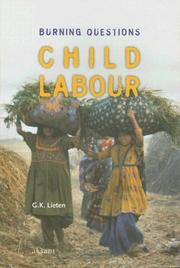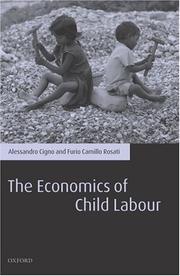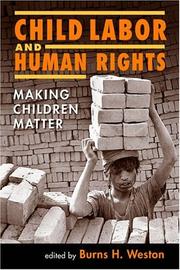| Listing 1 - 10 of 22 | << page >> |
Sort by
|
Book
Year: 2005 Publisher: [Washington, D.C. : World Bank,
Abstract | Keywords | Export | Availability | Bookmark
 Loading...
Loading...Choose an application
- Reference Manager
- EndNote
- RefWorks (Direct export to RefWorks)
"Although there is extensive literature on the determinants of child labor and many initiatives aimed at combating it, there is limited evidence on the consequences of child labor on socioeconomic outcomes such as education, wages, and health. Beegle, Dehejia, and Gatti evaluate the causal effect of child labor participation on these outcomes using panel data from Vietnam and an instrumental variables strategy. Five years subsequent to the child labor experience, they find significant negative effects on school participation and educational attainment, but also find substantially higher earnings for those (young) adults who worked as children. The authors find no significant effects on health. Over a longer horizon, they estimate that from age 30 onward the forgone earnings attributable to lost schooling exceed any earnings gain associated with child labor and that the net present discounted value of child labor is positive for discount rates of 11.5 percent or higher. The authors show that child labor is prevalent among households likely to have higher borrowing costs, that are farther from schools, and whose adult members experienced negative returns to their own education. This evidence suggests that reducing child labor will require facilitating access to credit and will also require households to be forward looking. This paper--a joint product of the Investment and Growth and Poverty Teams, Development Research Group--is part of a larger effort in the group to understand the causes of poverty and child labor. The study was funded by the Research Support Budget under the research project 'Child Labor and Access to Credit.'"--World Bank web site.
Book
Year: 2005 Publisher: [Washington, D.C. : World Bank,
Abstract | Keywords | Export | Availability | Bookmark
 Loading...
Loading...Choose an application
- Reference Manager
- EndNote
- RefWorks (Direct export to RefWorks)
"Although there is extensive literature on the determinants of child labor and many initiatives aimed at combating it, there is limited evidence on the consequences of child labor on socioeconomic outcomes such as education, wages, and health. Beegle, Dehejia, and Gatti evaluate the causal effect of child labor participation on these outcomes using panel data from Vietnam and an instrumental variables strategy. Five years subsequent to the child labor experience, they find significant negative effects on school participation and educational attainment, but also find substantially higher earnings for those (young) adults who worked as children. The authors find no significant effects on health. Over a longer horizon, they estimate that from age 30 onward the forgone earnings attributable to lost schooling exceed any earnings gain associated with child labor and that the net present discounted value of child labor is positive for discount rates of 11.5 percent or higher. The authors show that child labor is prevalent among households likely to have higher borrowing costs, that are farther from schools, and whose adult members experienced negative returns to their own education. This evidence suggests that reducing child labor will require facilitating access to credit and will also require households to be forward looking. This paper--a joint product of the Investment and Growth and Poverty Teams, Development Research Group--is part of a larger effort in the group to understand the causes of poverty and child labor. The study was funded by the Research Support Budget under the research project 'Child Labor and Access to Credit.'"--World Bank web site.
Book
Year: 2005 Publisher: Washington, DC : World Bank,
Abstract | Keywords | Export | Availability | Bookmark
 Loading...
Loading...Choose an application
- Reference Manager
- EndNote
- RefWorks (Direct export to RefWorks)
"The authors use panel data for Mexico for 1997 to 1999 to test several assumptions regarding the impact of a conditional cash transfer program on child labor, emphasizing the differential impact on indigenous households. Using data from the conditional cash transfer program in Mexico--PROGRESA (OPORTUNIDADES)--they investigate the interaction between child labor and indigenous households. While indigenous children had a greater probability of working in 1997, this probability is reversed after treatment in the program. Indigenous children also had lower school attainment compared with Spanish-speaking or bilingual children. After the program, school attainment among indigenous children increased, reducing the gap. This paper--a product of the Education Sector Unit, Latin America and the Caribbean Region--is part of a larger effort in the region to evaluate human development programs"--World Bank web site.
Book
Year: 2005 Publisher: [Washington, D.C. : World Bank,
Abstract | Keywords | Export | Availability | Bookmark
 Loading...
Loading...Choose an application
- Reference Manager
- EndNote
- RefWorks (Direct export to RefWorks)
"The authors use panel data for Mexico for 1997 to 1999 to test several assumptions regarding the impact of a conditional cash transfer program on child labor, emphasizing the differential impact on indigenous households. Using data from the conditional cash transfer program in Mexico--PROGRESA (OPORTUNIDADES)--they investigate the interaction between child labor and indigenous households. While indigenous children had a greater probability of working in 1997, this probability is reversed after treatment in the program. Indigenous children also had lower school attainment compared with Spanish-speaking or bilingual children. After the program, school attainment among indigenous children increased, reducing the gap. This paper--a product of the Education Sector Unit, Latin America and the Caribbean Region--is part of a larger effort in the region to evaluate human development programs"--World Bank web site.
Book
ISBN: 1281198242 1435622294 9786611198244 0191532606 Year: 2005 Publisher: Oxford : Oxford University Press,
Abstract | Keywords | Export | Availability | Bookmark
 Loading...
Loading...Choose an application
- Reference Manager
- EndNote
- RefWorks (Direct export to RefWorks)
Children throughout the world are engaged in a great number of activities classifiable as work. These range from relatively harmless, even laudable, activities like helping parents in their domestic chores, to morally and physically dangerous ones like soldiering and prostitution. If we leave out the former, we are left with what are generally called ""economic"" activities. Only a small minority, less than 4 percent of all working children, are estimated to be engaged in what ILOdefines as the ""unconditional"" worst forms of child labour. The absolute number of children estimated to be engag
Book
ISBN: 9221161722 Year: 2005 Publisher: [Geneva] : International Labour Office,
Abstract | Keywords | Export | Availability | Bookmark
 Loading...
Loading...Choose an application
- Reference Manager
- EndNote
- RefWorks (Direct export to RefWorks)
In this manual, SIMPOC has developed a complete and self-contained training kit for practitioners collecting, processing, analyzing and reporting data related to child labour.

ISBN: 9052601852 9786613259431 1283259435 9048520991 9789048520992 9789052601854 Year: 2005 Publisher: Amsterdam
Abstract | Keywords | Export | Availability | Bookmark
 Loading...
Loading...Choose an application
- Reference Manager
- EndNote
- RefWorks (Direct export to RefWorks)
It is often said that children have always been working. With the onset of the industrial revolution in the nineteenth century, however, children became to be exploited under miserable circumstances in factories. That was the beginning of the movement against child labour. A worldwide awareness campaign has brought international organizations and governments to the position that child labour should urgently be replaced by child education. The objectives seem simple and laudable but the issues involved are very complex. What actually is child labour, and what is childhood? How many child labourers are there in the world? Is child labour restricted to developing countries or is it frequently used in order to stigmatize the non-Western world? Is regulation of labour conditions the solution or should governments and civil society one opt for a radical ban? Is there a role for corporate social responsibility? These questions have been addressed in the professorial address on Child Labour Studies. It is argued that much more research is needed and that particular care should be taken to learn from children on how they view the world and what they think of work, labour and education.
Child labor. --- Children --- Age and employment. --- Social conditions. --- Employment of children --- Employment --- Labor --- Age and employment --- Employment and age --- Employment (Economic theory) --- Ability, Influence of age on --- Child labor --- Post-retirement employment

ISBN: 0199264457 9780199264452 Year: 2005 Publisher: Oxford New-York : Oxford University Press,
Abstract | Keywords | Export | Availability | Bookmark
 Loading...
Loading...Choose an application
- Reference Manager
- EndNote
- RefWorks (Direct export to RefWorks)
Child labor --- Economic aspects --- 331 --- 174.4 --- 316 --- Arbeid. Labour economics. Arbeidseconomie --- Bedrijfsethiek. Zakenmoraal --- Sociologie --(algemeen) --- Child labor. --- 316 Sociologie --(algemeen) --- 174.4 Bedrijfsethiek. Zakenmoraal --- 331 Arbeid. Labour economics. Arbeidseconomie --- Children --- Employment of children --- Labor --- Age and employment --- Employment --- Child labor - Economic aspects --- Economie du travail --- Travail des enfants --- Aspects économiques

ISBN: 2845866666 2709915529 Year: 2005 Publisher: Paris : Karthala : Institut de recherche pour le développement,
Abstract | Keywords | Export | Availability | Bookmark
 Loading...
Loading...Choose an application
- Reference Manager
- EndNote
- RefWorks (Direct export to RefWorks)
Child labor --- Enfants --- Travail --- Accra (Ghana) --- Accra (Ghana) --- Accra (Ghāna) --- Accra (Ghana) --- Social conditions. --- Economic conditions --- Conditions sociales --- Conditions économiques

ISBN: 158826324X 1588263495 Year: 2005 Publisher: Boulder Rienner
Abstract | Keywords | Export | Availability | Bookmark
 Loading...
Loading...Choose an application
- Reference Manager
- EndNote
- RefWorks (Direct export to RefWorks)
Child labor. --- Human rights. --- Enfants --- Droits de l'homme (Droit international) --- Travail --- Child labor --- Human rights --- Basic rights --- Civil rights (International law) --- Rights, Human --- Rights of man --- Human security --- Transitional justice --- Truth commissions --- Children --- Employment of children --- Labor --- Age and employment --- Law and legislation --- Employment
| Listing 1 - 10 of 22 | << page >> |
Sort by
|

 Search
Search Feedback
Feedback About UniCat
About UniCat  Help
Help News
News